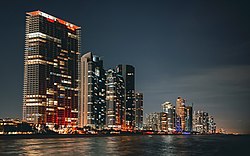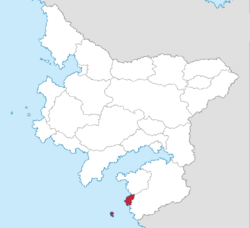Secano (province)
This article is incomplete because it is pending further input from participants, or it is a work-in-progress by one author. Please comment on this article's talk page to share your input, comments and questions. Note: To contribute to this article, you may need to seek help from the author(s) of this page. |
Secano | |
|---|---|
 View of the Secano skyline | |
|
Flag of Secano Flag | |
| Motto(s): | |
 Map of Carloso with Secano highlighted | |
| Country | |
| Capital | Secano |
| Circuits | Arteida, Secano, Tarin, Vencedor Island |
| Government | |
| • Type | Provincial government under a constitutional republic |
| • Body | Provincial Council |
| • Chief Minister | Valer Sisenande (NS) |
| • Deputy Minister | Delfín Tornentón (NS) |
| • Legislature | Provincial Assembly |
| Population (2022) | |
| • Total | 12,509,802 |
| Demonym | Secanian |
| Postcode area | SE |
| Official languages | |
| NAs | 51 (out of 859) |
| Website | secano |
Secano, officially the Province of Secano is a province of Carloso, composed of three circuits on the mainland and a fourth encompassing Vencedor Island off the Carlosian coast. Located in the south-east of the country, as of the 2017 census it had a population of 12,509,802. Its contiguous territory borders Muron to the north, Badasca to the east and south, and the Musgorocian Ocean to the west. The province is bisected by the Valera River. Secano's southerly position relative to the rest of Carloso means it typically experiences the hottest summers of the country, making it a major tourist destination. The sixth most populous province of Carloso, it is densely populated and a major centre for economic, cultural and political activities. It hosts a large Carlosian Navy base. The province's capital is also called Secano. As the economic centre of the south-east, it has many transport links, including a large airport; Secano International Airport, and high-speed Aris rail connections to Madrigal and Ninfas, Agostinia.
During the Emergency War (1946–1951), Secano was one of the first areas of Carloso to be invaded and occupied by Bourgougian forces. During the violent Siege of Secano, up to 80% of the buildings in the province were destroyed and thousands were killed, as Carlosian forces sought to tie up the invaders and delay the Bourgougian advance into Carloso's interior. The Viernes Archives, and adjacent Secano Cathedral were almost completely destroyed during the last stand of Colonel Arits Siurana and his forces in 1947. The city was retaken by Carlosian forces in the Liberation of Secano in 1948 and extensively rebuilt and expanded in the post-war period.
History
Pre-colonisation and settlement
Evidence suggests that the first Aboriginal Musgorocians settled in modern day Secano some time around 550 AD, however the vast forests and swamps of what is now Muron and Badasca prevented large communities from establishing themselves. When the Spanish began to arrive in Musgorocia in the early 1500s, Secano was the first area in present day Carloso to be colonised, when the Spanish landed at Maled and founded a trading outpost there in 1508. Within a short period, thousands of settlers arrived in the area and numerous villages and towns were founded, the largest being Secano itself, located strategically at the mouth of the Valera River. Prior to the founding of Madrigal in 1527, Secano served de facto as the capital of Nueva Orense. The discovery of gold at Brular and Soltera brought great wealth to the first Secanians, while the surrounding forests and wetlands were cleared for agriculture, flax becoming a major cash crop, encouraging even more settlement. The Spanish authorities soon planned for the expansion of Secano as a model city for the new continent, constructing many of the city's present-day oldest serving structures, including the Viernes Archives, the Alcásar of Secano, Merchants Hall, the Viceregal Palace and Secano Cathedral. Dominican missionaries began to establish themselves as educators and converted many of the Aboriginals to Catholicism, encouraging their integration into the society of their colonial overlords. Though its status waned as it was eclipsed by Madrigal in the 1530s, and would eventually supplant it as the capital of Nueva Orense, Secano would remain the second-most populous city throughout the colonial period and for over two centuries afterwards until the rise of Ebon in the late eighteenth century. Secano is therefore considered the oldest city in Carloso and, by extension, the surrounding province is considered primus inter pares as the birthplace of the country.
Early independence
British rule
Imperial era
Modern era
Though Secano continued to suffer from sporadic bombing raids and missile attacks for a year following its liberation, by early 1950 the Carlosian Air Force had established such overwhelming air superiority with the debut of the XF-88 Voodoo and later the F-86 Sabre, which rapidly depleted Bourgougia's air capabilities.
Georaphy
Politics
Legislature and government
The Provincial Council of Secano sits at the TBD Palace in TBD, Secano. As with all other legislatures in Carloso, it is unicameral, with 233 members, known as Provincial Assemblymen (PAs). Since 2012 it has been controlled by a National Salvation majority.
Administrative divisions
| Flag | Name | Population | Density (/km2) |
Area (km2) |
Districts |
|---|---|---|---|---|---|
| Arteida | 3,186,496 | TBD | 8 | ||
| Secano | 5,383,199 | TBD | 17 | ||
| Tarin | 2,952,085 | TBD | 6 | ||
| Vencedor Island | 988,022 | TBD | 3 | ||
Total
|
12,509,802 | ||||

